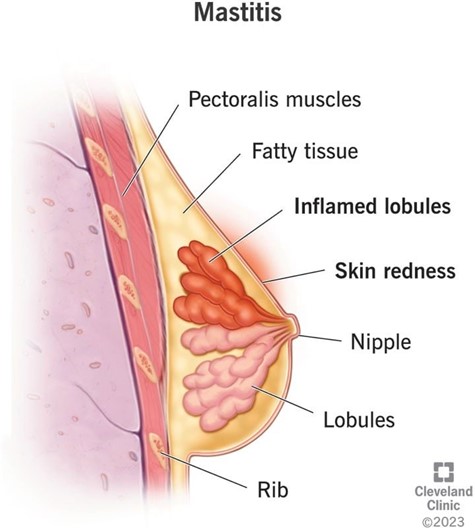A nurse is collecting data from a client who is 14 hr postpartum. The nurse notes breasts soft, fundus firm, slightly deviated to the right; moderate lochia rubra; temperature 37.7° C (100° F), pulse rate 88/min, respiratory rate 18/min. Which of the following actions should the nurse perform?
Encourage the client to nurse more frequently so her milk will come in.
Increase IV fluids.
Ask the client to empty her bladder.
Report the client's temperature elevation.
The Correct Answer is C
Choice A reason: Encourage the client to nurse more frequently so her milk will come in is incorrect, as this action is not related to the data collected by the nurse. The nurse notes that the client's breasts are soft, which indicates that the milk has not come in yet. This is normal and expected for a client who is 14 hr postpartum, as milk production usually begins around 72 to 96 hr after birth. The nurse should encourage the client to nurse frequently and effectively to stimulate milk production and prevent engorgement.
Choice B reason: Increase IV fluids is incorrect, as this action is not indicated by the data collected by the nurse. The nurse notes that the client's vital signs are within normal limits, except for a slight temperature elevation. Increasing IV fluids can cause fluid overload and electrolyte imbalance in the client. The nurse should maintain the IV fluids at the prescribed rate and monitor the client's intake and output.
Choice C reason: Ask the client to empty her bladder is correct, as this action is indicated by the data collected by the nurse. The nurse notes that the client's fundus is firm but slightly deviated to the right, which suggests bladder distension. A full bladder can interfere with uterine contraction and involution and increase the risk of hemorrhage and infection. The nurse should assist the client to empty their bladder and reassess the fundal position.
Choice D reason: Report the client's temperature elevation is incorrect, as this action is not necessary for a slight temperature elevation in a postpartum client. The nurse notes that the client's temperature is 37.7° C (100° F), which is slightly above normal but within the range of expected findings for a postpartum client. A mild temperature elevation in the first 24 hr after birth can be due to dehydration, exertion, or hormonal changes and does not indicate infection. The nurse should encourage oral fluid intake and monitor the temperature every 4 hr.
Nursing Test Bank
Naxlex Comprehensive Predictor Exams
Related Questions
Correct Answer is D
Explanation
Choice A reason: Swelling in both breasts is incorrect, as this finding does not indicate mastitis. Swelling in both breasts can occur due to engorgement, which is a normal and expected phenomenon in the first few days after birth or when milk production increases. Engorgement can cause breast fullness, tenderness, and warmth, but it does not cause infection or inflammation.
Choice B reason: Cracked and bleeding nipples is incorrect, as this finding does not indicate mastitis. Cracked and bleeding nipples can occur due to poor latch, improper positioning, or excessive suction of the baby. Cracked and bleeding nipples can cause pain, discomfort, and risk of infection, but they do not cause mastitis by themselves.
Choice C reason: Increase in breast milk is incorrect, as this finding does not indicate mastitis. Increase in breast milk can occur due to hormonal changes, frequent breastfeeding, or stimulation of the breasts. Increase in breast milk can cause engorgement, but it does not cause infection or inflammation.
Choice D reason: Red and painful area in one breast is correct, as this finding indicates mastitis. Mastitis is an infection and inflammation of the breast tissue that usually affects one breast at a time. Mastitis can cause redness, pain, swelling, warmth, and fever in the affected breast. Mastitis can occur due to blocked milk ducts, bacterial invasion, or poor hygiene. The nurse should advise the client to continue breastfeeding or pumping, apply warm compresses, massage the breast gently, and take antibiotics as prescribed.

Correct Answer is B
Explanation
Choice B reason:
Auscultating the client's abdomen is the first action the nurse should take, as it can assess the return of bowel function after surgery. The nurse should listen for bowel sounds in all four quadrants, and note their frequency and quality.
Offering clear liquids is an important action, as it can provide hydration and nutrition for the client. However, this is not the first action the nurse should take, as it may cause nausea and vomiting if the client's bowel function has not returned.
Choice C reason:
Checking the client's chart for a diet prescription is an important action, as it can ensure that the client follows the provider's orders and does not consume anything contraindicated. However, this is not the first action the nurse should take, as it does not address the client's hunger or bowel function.
Choice D reason:
Giving the client soda crackers is an important action, as it can provide a bland and easily digestible food for the client. However, this is not the first action the nurse should take, as it may be too solid for the client's stomach if her bowel function has not returned.
Whether you are a student looking to ace your exams or a practicing nurse seeking to enhance your expertise , our nursing education contents will empower you with the confidence and competence to make a difference in the lives of patients and become a respected leader in the healthcare field.
Visit Naxlex, invest in your future and unlock endless possibilities with our unparalleled nursing education contents today
Report Wrong Answer on the Current Question
Do you disagree with the answer? If yes, what is your expected answer? Explain.
Kindly be descriptive with the issue you are facing.
